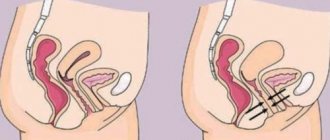Causes of pain
By the end of pregnancy, the uterus becomes the largest internal organ in the body. Moreover, it does not grow, but stretches. It is much more difficult to endure pain during contractions during a period when the volume of the uterus is increased 500 times, due to the area of the irritated segment.
What can you compare the pain of labor contractions to? 70% of mothers say with sensations during a tissue cut. Many compare the pain to a burn to the genitals. It has been scientifically proven that only amputation and rupture of nerve fibers are more painful. Stimulates the intensity of the mother's fear and panic reaction.
Influencing factors:
- cervical dilatation;
- Christmastide tension;
- pelvic muscle resistance;
- temporary tissue ischemia;
- deformation of the uterine vessels, which have highly sensitive receptors;
- lack of control, the psyche is not ready for reduction.
Medications such as local, epidural and general anesthesia help you survive labor and childbirth. If a woman in labor concentrates only on pain, metabolic processes in the plasma are disrupted, and there is a risk of complications during childbirth. Correct behavior, readiness for the start of contractions, control of the uniformity and intervals of contractions helps to increase the pain threshold.
Is it possible to have contractions without pain? Not if the true labor process has begun. Stone in the abdomen, without signs of pain, means training contractions.
There is a relationship between physiological factors, periods of flow and the degree of sensitivity. Women with painful menstruation and associated pathologies have a hard time enduring labor pains.
At-risk groups:
- large fruit;
- first pregnancy;
- prolonged labor;
- early discharge of amniotic fluid;
- use of oxytocin;
- chronic diseases of the genitourinary system.
What hurts more: contractions or childbirth? Moms say they are having contractions. Muscular contractions of the uterus reach their peak before the start of pushing, the pain becomes sharp, and the pressure of the fetus on the cervix increases.
How does a woman feel during contractions?
Believe me, girls, you will definitely understand that labor has begun. It is impossible to confuse
: pain during a contraction originates somewhere in the back, grows, rolls like a wave, moves down to the hips, at the same time radiating to the stomach. This is a very specific experience, only possible during childbirth.
And let's immediately tune in to the fact that the fight is never long - its duration is 15-60 seconds
.
Just a minute of strong sensations when the muscles diligently open the cervix, and then nature will give you a rest
.
The interval between contractions is quite long at first - half an hour, 20 minutes, 15 minutes. The rest period is reduced gradually. When the intervals between muscle tension of the woman in labor are 3-5 minutes, this is a full birth
, you should already be under the supervision of an obstetrician at this time. Sometimes 3 hours, sometimes a day can pass between this and the initial stage.
Pain relief methods
If at the beginning of labor a woman is at home, contractions are not yet counted at systematic intervals, and you don’t have to stop everyday activities. It is recommended to move, clean up, put things in maternity hospital bags and documents. When increasing frequency, monitoring the regularity of contractions of the uterine muscles, special techniques are used to alleviate the pain syndrome.
How to better cope with labor pains during childbirth:
- applying heat;
- warm bath;
- correct breathing;
- massage;
- anesthesia.
Applying heat. For pain relief at home, heated containers are used - an enema with water, a thick bag with flax or barley grains. You can take a piece of thick fabric, pour oats and wheat into it, and tie the ends together. The bag is heated in the microwave until warm and applied to the sacral lumbar region for 15-20 minutes. The technique relaxes muscles, relieves spasms, relieves pain, and helps to properly survive contractions during childbirth.
Bath. It is recommended to be in warm water when the pain is still tolerable; the bath should have a temperature of up to 37.5 C. You cannot lie on your back; lying on your side will stimulate blood circulation and supply oxygen. You need to relax, count to 100, roll over. Place a soft rubber mat on the bottom of the bath and a pillow under your head.
Breath. Techniques change as the fight progresses. At the initial stage, when the intervals between contractions are 5-7 minutes, you need to breathe deeply, with your stomach. Inhale for 3-4 seconds, exhale for 6 seconds.
When the frequency decreases to 3 minutes, the duration of the contraction increases to 2-2.5 minutes, you need to inhale for 4 counts, exhale for 5. At the peak of the contraction, breathe often, not deeply. Before pushing, try to choose a measured rhythm, inhale through your nose, exhale through your mouth. As air leaves the lungs, push the fetus out.
Massage helps you endure labor pains. The procedure must be carried out from the beginning of the first contractions, until the moment of pushing. You can use pain-relieving gels, creams, Vaseline ointments, oil, if the risk of an allergic reaction is excluded.
Spot. Simultaneously press on the indentation between the thumb and index finger, on the outside of the hand, and on the ankle bone, on the inside. The movements are short, intense, duration 40 seconds, the impact hand is located parallel to the floor.
Stroking. Palms fold left over right in the lower abdomen, moving from the center to the sides. The pads gently massage the skin; at the peak of contraction, the pressure increases.
Sacral. Using finger bones and a vibrating massager, the peri-sacral area is massaged with intense circular movements for 30-40 seconds. During the break, use the pads of your fingers to apply light pressure on the sacrum and the hollows above the buttocks.
Thigh rubbing. You need to lie on your side, bend your knees and put them together. Place your palm on the inner thigh, rub the surface from the knee to the groin, 30 times on each side, with a comfortable hand.
Anesthesia. The local or regional method is more often used. General anesthesia is used in 2% of cases, in complex cases, or previous spinal injuries:
Types of anesthesia:
- local - for pain relief in specific areas, if there are ruptures, the need for sutures;
- epidural, spinal - the drug is injected into the back, blocking the sensitivity of the lower half of the body without stopping contractions;
- general – complete loss of consciousness, labor without pain.
Anesthesia, despite the wishes of women in labor, is not recommended by doctors without appropriate indications. Often the decision is made urgently, at the second stage of delivery, if the pain threshold is exceeded, there is loss of consciousness, or surgical intervention is necessary.
Pros and cons of anesthesia
As you can see, the picture is not very pleasant. So what to do? Is it possible to somehow alleviate a woman’s condition and make childbirth less of a frightening event?
Naturally, it is possible, and modern medicine provides a lot of opportunities for this - from complete drug anesthesia of childbirth to breathing techniques and unconventional methods of relaxation and relaxation.
Each method has its own advantages and disadvantages, and the woman in labor makes the choice in favor of one or another anesthesia independently or together with her obstetrician.
We will not convince dear ladies that any option is clearly better than others, but will simply list the pros and cons of the main methods of pain relief. drug anesthesia, traditional for modern medicine .
Anesthesia with narcotic analgesics
Most often, at the very beginning of contractions, a woman in labor is anesthetized, just in case, through intramuscular or intravenous administration of narcotic analgesics.
promedol is used for this , which has a lesser effect on the condition of the fetus and the activity of labor. The pain relief method is very simple and accessible, but rarely effective (does not work during strong contractions), and is also extremely unsafe (depresses the nervous system of the fetus and can subsequently cause serious neurological disorders). Opioid analgesics are thought to help a woman in labor rest between contractions and maintain the strength to push. In fact, the same effect can be achieved independently and without the use of drugs - using breathing or working with the voice.
Inhalation anesthesia
In some maternity hospitals, inhalation anesthesia is carried out during contractions , that is, in the intervals between contractions, the woman is asked to inhale a mixture of nitrous oxide and oxygen .
It helps in about half of the cases, but in general it is a rather useless and unsafe procedure , since nitrous oxide has a depressing effect on the brain (both mother and fetus). Again, weakness of labor, respiratory depression in the newborn and other troubles cannot be ruled out.
Local anesthesia
Another favorite way for obstetricians to ease the birth process is local anesthesia , in which the skin, subcutaneous tissue and muscles in the right place are saturated with a local anesthetic solution through several injections . It can be used at the very end of childbirth (sometimes after the birth of the child) to remove the placenta and perform minor operations (suturing tears and cracks in the birth canal). It is not dangerous , since the analgesic substance practically does not enter the systemic bloodstream and acts only at the injection site, but it relieves pain very well.
Epidural anesthesia
The most popular method of pain relief among doctors and women in labor is epidural anesthesia . Epidural almost completely relieves pain of any intensity . At the same time, the anesthesiologist can easily monitor the condition of the woman in labor and the fetus, which reduces the danger of this type of anesthesia, the soft tissues of the birth canal continue to perform their function, the woman is conscious and the baby is born naturally .
True, this type of pain relief looks rather scary to the uninitiated person. The woman is asked to take a sitting position and slightly arch her back, then the doctor finds the right place in the lumbar spine and numbs it (regular local anesthesia). Then, using a special needle, a thin and flexible epidural catheter is inserted into the intrathecal space of the spinal cord (which may be accompanied by unpleasant sensations in the legs). Now the needle is removed, the catheter is left in place and a special local anesthetic is injected .
The full effect of anesthesia develops after 10 - 20 minutes and lasts until the end of labor, and in some cases in the first few hours after its completion (depending on the drug). The woman in labor stops experiencing pain, but feels the baby moving along the birth canal, that is, she is able to push and control the situation. There is a type of epidural anesthesia that allows you to sit and walk - the so-called mobile epidural anesthesia .
It must be said that with all the advantages, this method is not without its disadvantages, which, as a rule, are associated with improper execution of anesthesia. The most common situation is inaccurate delivery of the analgesic and, as a result, partial blockade of pain . It is possible that a needle will puncture one of the membranes of the spinal cord , which in the postpartum period leads to prolonged and intense headaches .
An inexperienced anesthesiologist has a high risk of damaging small vessels of the spine , which causes inflammation of the meninges .
Such troubles can be listed for a very long time, so before agreeing to epidural anesthesia, be sure to find out the level of experience of the anesthesiologist!
Phases of contractions
Uterine contractions, stimulating cervical dilatation, and the release of the fetus occupy 70% of labor. For some women, this stage ends within 1 hour, while for others it lasts more than a day.
How many hours does a woman give birth? The first birth lasts 8-15 hours, the second 3-4 hours less. Features of the course and duration are individual; there are cases of painless labor in 1.5-2 hours in the first pregnancy, and up to 15 hours in the second.
The preparation of the uterus takes place in 3 stages. The hardest time to endure labor pains is in the period before pushing.
Phases:
- latent;
- active;
- early;
- pushing.
Latent. It lasts 4-8 hours, during this period a woman can calmly get ready at home, do household chores, and wait for the car to the maternity hospital. The cervix begins to dilate, the pain is weak. You need to move more, take a bath, drink tea with mint and thyme. Breathe calmly, deeply.
Active. The cervix dilates to 8 cm, the amniotic sac bursts with the release of amniotic fluid. During this phase, you need to be in the maternity hospital; massage will help you endure the pain during contractions: acupressure, sacral, stroking. If there is no indication, do not lie down, it is better to walk along the corridor.
Early. The cervix opens completely, at this stage the pain is comparable to a cut in living tissue. You need to switch your breathing to diaphragmatic breathing. Be sure to move; a position on all fours or squats will ease the pain of contractions. You cannot push during this phase.
Pushing. In this state, the fetus begins to move outward. You need to listen to the midwife. While pushing, you can’t scream or put your legs together.
There are cases in history when a baby was born in 2 minutes. This happened in the UK, the mother was a woman for whom this rapid birth was not the first. She was already raising a son born in an hour.
How long was the longest labor? It took 10 weeks and 5 days for triplets to be born to a resident of Poland, D. Krzysztonek. The children were born healthy and strong, and the mother in labor was discharged from the hospital as usual.
Epidural anesthesia
Some women prefer to live the entire process of childbirth from beginning to end, to experience these unforgettable sensations, despite their excruciating and unrealistic pain. If you can handle it with just a massage or a positive attitude, great. But sometimes the situation gets out of control when it is no longer possible to endure the pain. If you are having difficulty and can no longer bear the pain, know that you can always ask for pain relief.

In this case, you will receive an epidural. She is guaranteed to help cope with the situation.
Found a violation? Report content
Breathing system for easy birth
Deep breathing during the first stage of labor
To learn how to endure childbirth painlessly and ensure the health of your child, you should master the technique of proper breathing during pregnancy. By concentrating on breathing, a woman is distracted from pain and can easily relax her whole body, which helps give birth as quickly as possible and with minimal discomfort. When breathing deeply at the beginning of labor, inhalation should be through the nose and exhalation through the mouth. It is necessary to begin such breathing as a new contraction increases and complete deep breathing sessions when the contraction passes. In a minute you can take from 6 to 9 deep breaths. When the contraction lasts about half a minute, 3 to 6 inhalations and exhalations are taken.
Controlled breathing during the second stage of labor
As the cervix dilates, the duration of each contraction increases; this must be taken calmly. The presence of pain indicates that everything is going right. It is optimal to practice controlled breathing during contractions that last 1-3 minutes. In this mode, shallow breathing should predominate, implying some acceleration. The increase in pain during a contraction occurs slowly, while the woman has time to take several deep breaths through the chest, and when the pain intensifies, concentrate on more shallow breathing, increasing it at the peak of the contraction. As the pain impulse subsides, you should breathe less and less and end this session with a deep inhalation and exhalation.
Cleansing Breathing in the Third Stage of Labor
The final stage of cervical dilatation should be marked by a special cleansing breath. The contractions are painful and there are short pauses between them. To improve well-being, a woman needs to take one deep breath and exhale. Next, do 4 shallow and frequent inhalations and exhalations. After this, again inhale forcefully through your nose and exhale slowly through your mouth. Then the cycle is repeated: 4 frequent inhalations and exhalations in a row, 1 deep inhalation and 1 long exhalation.
Breathing in the fourth stage of labor
During pushing, you should also pay special attention to breathing. Doctors will definitely tell you how and when to push. During this important period of childbirth, you should try to take a deep breath into your chest, then exhale equally deeply through your chest. To properly take a full chest breath, you need to collect a large volume of air in the chest and abdomen. Next, you need to hold your breath for half a minute or a little more, and then slowly blow out the air through your mouth, as when blowing out candles. Pressing your chin to your chest and looking at your navel, you should push at the right moment, directing maximum effort down your abdomen. Within one contraction, a woman manages to tense up 2-3 times, trying to push the baby out. During all stages of labor, remember to take deep breaths and the utmost importance of remaining calm.
A conscientious mother should contact a specialist in advance who can assess and improve the situation, taking into account the individual characteristics of the body and the characteristics of the course of pregnancy. The doctor will be able to tell you in detail how to endure childbirth painlessly and leave only positive and bright memories of this process. During contractions, a woman’s position can be any, the main thing is to always be under the control of doctors, not to scream and to comply with their demands. For some women, breathing and a light massage of the lower back helps them easily survive contractions, for others the presence of their husband is important, and still others choose drug pain relief.
Good afternoon and good mood to everyone reading my blog! One of the most significant events in a woman’s life is the birth of her child. Holiday, birthday! Cake, candles, gifts. But, unfortunately, many women remember their childbirth not as a holiday at all, but as “horror, a nightmare, endless torture.” Why does this depend, and how to survive childbirth and labor without receiving psychological trauma for life?










